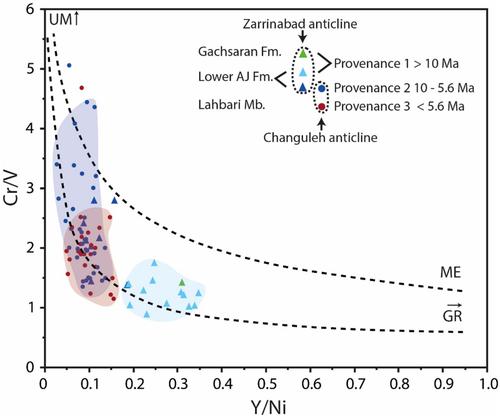当前位置:
X-MOL 学术
›
Basin Res.
›
论文详情
Our official English website, www.x-mol.net, welcomes your
feedback! (Note: you will need to create a separate account there.)
A revised model for Neogene Zagros foreland sedimentation in the Lurestan arc based on new geochemical data
Basin Research ( IF 2.8 ) Pub Date : 2024-03-30 , DOI: 10.1111/bre.12861 Christian A. F. Dietzel 1 , Uwe Kirscher 1, 2 , Christoph Berthold 3 , Mahmoud Reza Majidifard 4 , Madelaine Böhme 1, 5
Basin Research ( IF 2.8 ) Pub Date : 2024-03-30 , DOI: 10.1111/bre.12861 Christian A. F. Dietzel 1 , Uwe Kirscher 1, 2 , Christoph Berthold 3 , Mahmoud Reza Majidifard 4 , Madelaine Böhme 1, 5
Affiliation

|
The Zagros foreland basin is an important sedimentary archive for the tectonic and paleoclimatic evolution of the Zagros Mountains and the entire Neotethyan Arabia–Iran collision zone. By combining new geochemical high‐resolution whole rock XRF data with clay mineralogy and soluble salt geochemistry we propose an evolution of the sedimentary environment in the Lurestan arc from the Serravallian to the early Pleistocene, closing a gap in understanding the complex exhumation history of the central Zagros mountain belt. An increase in ultramafic sedimentary input indicates a shift from provenance 1 to provenance 2 by ophiolite exhumation at ca.10 Ma in the Imbricated Zagros north of the Lurestan arc. Our data further indicates that the sedimentary environment of parts of the Lahbari Mb within the Lurestan arc represents a piedmont deposition of fine‐grained alluvial fans and siltstones with aeolian contribution deposited under hyper‐arid climate conditions. These represent provenance shift 3 and were likely sourced from evaporites of the underlying Gachsaran Fm and fluvial deposits of the Lower Aghajari Mb (provenance 1 and provenance 2), uplifted by the Mountain Front Flexure at around 5.6 Ma. Combining XRF whole rock data with clay mineral data refines formation conditions of the clay minerals in the foreland basin such as palygorskite, which is revealed to be authigenic in origin in the Lower Aghajari Mb. as a function of varying Mg‐content due to variations of erosion of the ultramafic and mafic rocks in the Imbricate Zagros belt. Palygorskite in the Lahbari Member is likely both inherited from the Neogene Gachsaran evaporites as well as of authigenic origin.
中文翻译:

基于新地球化学数据的卢雷斯坦弧新近纪扎格罗斯前陆沉积修正模型
扎格罗斯前陆盆地是扎格罗斯山脉和整个新特提斯期阿拉伯-伊朗碰撞带的构造和古气候演化的重要沉积档案。通过将新的地球化学高分辨率全岩 XRF 数据与粘土矿物学和可溶性盐地球化学相结合,我们提出了卢雷斯坦岛弧从塞拉瓦利亚到早更新世的沉积环境的演化,弥补了理解中部地区复杂折返历史的空白。扎格罗斯山带。超镁铁质沉积输入的增加表明,在卢雷斯坦弧以北的瓦状扎格罗斯,大约 10 Ma 处蛇绿岩折返导致从物源 1 向物源 2 的转变。我们的数据进一步表明,卢雷斯坦弧内的拉赫巴里火山部分地区的沉积环境代表了在极度干旱气候条件下沉积的细粒冲积扇和粉砂岩的山前沉积,并具有风成作用。这些代表物源变化 3,可能来自底层 Gachsaran 组的蒸发岩和下阿加贾里 Mb 的河流沉积物(物源 1 和物源 2),在 5.6 Ma 左右被山前弯曲所抬升。将 XRF 全岩石数据与粘土矿物数据相结合,完善了前陆盆地粘土矿物(如坡缕石)的形成条件,坡缕石被揭示为自生于下阿加贾里 Mb。由于叠瓦状扎格罗斯带中超镁铁质和镁铁质岩石的侵蚀变化而导致镁含量变化的函数。 Lahbari 段中的坡缕石很可能继承自新近纪 Gachsaran 蒸发岩以及自生起源。
更新日期:2024-03-30
中文翻译:

基于新地球化学数据的卢雷斯坦弧新近纪扎格罗斯前陆沉积修正模型
扎格罗斯前陆盆地是扎格罗斯山脉和整个新特提斯期阿拉伯-伊朗碰撞带的构造和古气候演化的重要沉积档案。通过将新的地球化学高分辨率全岩 XRF 数据与粘土矿物学和可溶性盐地球化学相结合,我们提出了卢雷斯坦岛弧从塞拉瓦利亚到早更新世的沉积环境的演化,弥补了理解中部地区复杂折返历史的空白。扎格罗斯山带。超镁铁质沉积输入的增加表明,在卢雷斯坦弧以北的瓦状扎格罗斯,大约 10 Ma 处蛇绿岩折返导致从物源 1 向物源 2 的转变。我们的数据进一步表明,卢雷斯坦弧内的拉赫巴里火山部分地区的沉积环境代表了在极度干旱气候条件下沉积的细粒冲积扇和粉砂岩的山前沉积,并具有风成作用。这些代表物源变化 3,可能来自底层 Gachsaran 组的蒸发岩和下阿加贾里 Mb 的河流沉积物(物源 1 和物源 2),在 5.6 Ma 左右被山前弯曲所抬升。将 XRF 全岩石数据与粘土矿物数据相结合,完善了前陆盆地粘土矿物(如坡缕石)的形成条件,坡缕石被揭示为自生于下阿加贾里 Mb。由于叠瓦状扎格罗斯带中超镁铁质和镁铁质岩石的侵蚀变化而导致镁含量变化的函数。 Lahbari 段中的坡缕石很可能继承自新近纪 Gachsaran 蒸发岩以及自生起源。






























 京公网安备 11010802027423号
京公网安备 11010802027423号